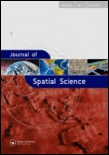
Journal of Spatial Science
Scope & Guideline
Exploring the Frontiers of Spatial Knowledge
Introduction
Aims and Scopes
- Geospatial Data Analysis:
The journal emphasizes the analysis of geospatial data through various statistical and computational methods, including machine learning and deep learning techniques, to derive insights that inform land use planning, environmental monitoring, and disaster management. - Remote Sensing Applications:
A core area of focus is the application of remote sensing technologies for environmental monitoring, urban planning, and resource management, utilizing satellite and aerial imagery to assess land cover changes, vegetation health, and climate impacts. - Spatial Modeling and Simulation:
The journal publishes research on spatial modeling techniques that simulate real-world phenomena, aiding in understanding spatial dynamics and predicting future trends in urban development, environmental changes, and resource allocation. - Geographic Information Systems (GIS):
Research related to GIS is prominent, especially studies that explore new methodologies for spatial data visualization, analysis, and management to enhance decision-making processes in various sectors. - Interdisciplinary Approaches:
The journal encourages interdisciplinary research that combines spatial science with fields such as ecology, urban studies, agriculture, and disaster management, fostering comprehensive solutions to complex spatial issues.
Trending and Emerging
- Machine Learning and Deep Learning:
There is a significant increase in the use of machine learning and deep learning methodologies for various applications, including land cover classification, anomaly detection, and environmental monitoring, indicating a shift towards data-driven approaches. - Multi-Sensor Data Integration:
Research integrating data from multiple sensors (e.g., satellite, UAV, and ground-based) is on the rise, showcasing the importance of comprehensive data collection methods for accurate spatial analysis and decision-making. - Environmental Monitoring and Climate Change:
The journal is witnessing a growing focus on studies that address environmental monitoring and the impacts of climate change, reflecting global concerns and the need for effective management strategies. - Urban Dynamics and Smart Cities:
There is an increasing emphasis on research related to urban dynamics, smart city planning, and sustainability, as urbanization continues to pose challenges that require innovative spatial solutions. - 3D and 4D Spatial Analysis:
Emerging research in 3D and 4D spatial analysis techniques is becoming more prevalent, reflecting advancements in technology and the need to analyze spatial phenomena in more complex dimensions.
Declining or Waning
- Traditional Statistical Methods:
There is a noticeable decline in the publication of papers employing traditional statistical methods for spatial analysis, as newer, more advanced computational techniques such as machine learning and deep learning gain prominence. - Basic GIS Applications:
Research focused solely on fundamental GIS applications without integrating advanced technologies or methodologies has become less frequent, indicating a shift towards more complex and innovative applications of GIS. - Single-Method Studies:
The trend is moving away from studies that rely on a single methodological approach. Instead, there is a growing preference for multi-method or interdisciplinary studies that leverage various techniques for more robust findings. - Static Spatial Models:
Papers that present static models without considering dynamic spatial changes or temporal factors are becoming less common, as researchers increasingly recognize the importance of temporal dynamics in spatial analysis.
Similar Journals
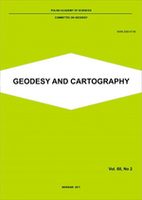
Geodesy and Cartography
Pioneering Research in Geodesy and Geographic Information ScienceGeodesy and Cartography, published by the Polska Akademia Nauk (Polish Academy of Sciences), is a premier open-access journal dedicated to advancing the fields of geodesy, cartography, and geographic information science. Since its inception in 2010, the journal has provided a vital platform for researchers, professionals, and students to share their findings, fostering innovation and collaboration in these critical areas of study. With its ISSN 2080-6736 and E-ISSN 2300-2581, the journal is accessible to a global audience, ensuring that cutting-edge research is readily available to enhance scientific understanding and application. The journal not only serves as a repository of knowledge but also aims to contribute to the development of best practices and methodologies within geospatial sciences, making it an essential resource for anyone invested in the ever-evolving landscape of mapping and spatial data analysis.

Geomatik
Exploring the frontiers of geospatial innovation.Geomatik is a pioneering open-access journal dedicated to advancing the field of geomatics, encompassing disciplines such as geospatial data analysis, remote sensing, and geographic information systems. Founded in 2016 by the esteemed Geomatik Journal publisher, this peer-reviewed platform aims to disseminate high-quality research and innovative methodologies to a global audience. With its E-ISSN 2564-6761, Geomatik facilitates accessibility to cutting-edge studies that address vital challenges in environment monitoring, urban planning, and spatial data management. The journal not only encourages collaboration among researchers and practitioners but also serves as an essential resource for students seeking to deepen their understanding of geomatic sciences. Its commitment to open access fosters scholarly exchange and enhances visibility for authors, contributing to significant advancements within the geomatics community.

GEOGRAPHICAL REVIEW
Charting New Territories in Earth-Surface StudiesGEOGRAPHICAL REVIEW, published by Taylor & Francis Inc, is a premier academic journal recognized for its influential contributions to the fields of geography and earth-surface processes. With an ISSN of 0016-7428 and an E-ISSN of 1931-0846, this journal has established itself as a vital resource for researchers, professionals, and students alike. The journal maintains a strong reputation with a Q1 ranking in both Earth-Surface Processes and Geography, Planning and Development, reflecting its scholarly impact and relevance in the academic community. Additionally, it holds a notable position in Scopus rankings, placing #181 out of 821 in Social Sciences and #45 out of 179 in Earth and Planetary Sciences. Although it is not open access, the GEOGRAPHICAL REVIEW remains essential for those seeking to expand their understanding of spatial analysis and environmental processes from its historical inception in 1969 to its ongoing publications through 2024. Explore rigorous research articles, critical reviews, and innovative studies that shape the discourse in geography and earth sciences today.

Geo-Spatial Information Science
Advancing the Frontiers of Geo-Spatial ResearchGeo-Spatial Information Science, published by TAYLOR & FRANCIS LTD, is a premier open-access journal that has been at the forefront of disseminating cutting-edge research since its inception in 1998. With an ISSN of 1009-5020 and an E-ISSN of 1993-5153, this journal plays a pivotal role in the fields of Computers in Earth Sciences and Geography, Planning and Development, achieving a prestigious Q1 ranking in both categories as of 2023. Its exemplary Scopus rankings highlight its relevance within the social sciences and earth sciences, placing it among the top echelons of its field, with a 95th and 93rd percentile respectively. The journal aims to bridge the gap between innovative geospatial technologies and their applications in real-world scenarios, fostering interdisciplinary collaboration and advancing the global understanding of spatial data analysis. Based in the United Kingdom, Geo-Spatial Information Science invites researchers, professionals, and students to contribute and access research that shapes the future of geo-spatial sciences, all while adhering to open access principles that ensure broad dissemination and engagement with the broader academic community.

Journal of Geographical Sciences
Navigating the Landscape of Innovative Geographical Studies.Welcome to the Journal of Geographical Sciences, a premier publication in the field of Earth and Planetary Sciences that has consistently demonstrated its impact and relevance since its inception in 2001. Published by SCIENCE PRESS, this esteemed journal is recognized for its rigorous peer-review process and high-quality research, achieving an impressive Q1 ranking in the 2023 category of Earth and Planetary Sciences (miscellaneous). With the latest Scopus ranking placing it at Rank #13 of 159, putting it in the top 8% of its field, the journal serves as a vital platform for disseminating significant findings and innovative methodologies in geography, environmental studies, and related disciplines. Although not an open-access journal, it offers exceptional visibility through its publication standards and accessibility in academic databases. Based in Beijing, China, the Journal of Geographical Sciences continues to pave the way for scholarly discourse and collaborative research, appealing to researchers, practitioners, and students dedicated to advancing our understanding of geographical phenomena.

ISPRS International Journal of Geo-Information
Exploring the intersections of geography and innovation.ISPRS International Journal of Geo-Information, published by MDPI, stands at the forefront of the field of geospatial sciences, contributing valuable knowledge and research insights since its inception in 2012. This open access journal, which boasts an impressive collection of articles that emphasize the integration of geographic information systems (GIS) in Earth and planetary sciences, currently achieves a remarkable standing, with a 2023 impact factor ranking in the Q1 category for both Earth and Planetary Sciences and Geography, Planning and Development. Researchers and professionals engaged in the study of spatial data, remote sensing, and innovative geoinformation technologies will find the journal an essential resource, offering diverse perspectives and methodologies. With its open access model, the journal aims to promote the dissemination of knowledge globally, fostering collaboration among scholars while pushing the boundaries of research in geoinformation disciplines. The journal is based in Switzerland and is well-positioned to contribute significantly to the understanding and application of geospatial data for societal advancements.
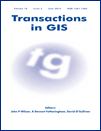
Transactions in GIS
Empowering Researchers with Cutting-Edge GIS KnowledgeTransactions in GIS is a premier academic journal published by WILEY, dedicated to advancing the field of Geographic Information Science (GIS). With an ISSN of 1361-1682 and an E-ISSN of 1467-9671, this journal has continually contributed valuable insights since its inception in 1996, transforming the landscape of GIS research and application. Covering a broad scope within Earth and Planetary Sciences, it holds a notable Q2 ranking and stands in the 74th percentile among its peers as per Scopus rankings. The journal serves as a critical platform for researchers, professionals, and students who seek to disseminate and engage with innovative GIS methodologies, applications, and theoretical advancements. With a commitment to quality and rigor, Transactions in GIS remains a vital resource for those at the forefront of geographic research and analysis.
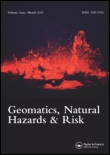
Geomatics Natural Hazards & Risk
Uncovering Insights into Natural Disasters and Risk MitigationGeomatics Natural Hazards & Risk, published by TAYLOR & FRANCIS LTD, is a premier open-access journal that has been at the forefront of interdisciplinary research since 2010, addressing critical issues related to natural hazards and environmental risk management. With an impressive impact factor and ranking in the Q1 quartile in both Earth and Planetary Sciences and Environmental Science categories, this journal serves as a vital platform for researchers, professionals, and students dedicated to advancing knowledge in these fields. The journal's commitment to open access since 2016 ensures that its high-quality research is readily available to a global audience, fostering collaboration and innovation. Located in the United Kingdom, Geomatics Natural Hazards & Risk encompasses a broad scope of studies including geospatial technologies, risk assessment methodologies, and the societal impacts of natural disasters, making it an essential resource for anyone involved in the investigation and mitigation of natural hazards.

Journal of Geovisualization and Spatial Analysis
Empowering Scholars with Open Access to Geospatial DiscoveriesJournal of Geovisualization and Spatial Analysis, published by SpringerNature, is an influential open-access journal specializing in the cutting-edge fields of geovisualization, spatial analysis, and their application in earth sciences and geography. Since its inception in 2017, this journal has established a prominent stance with a high impact factor and prestigious Q1 rankings across multiple categories, including Computers in Earth Sciences, Earth and Planetary Sciences (miscellaneous), and Geography, Planning and Development. The editorial board is committed to advancing innovative research and methodologies, providing a platform for scholars to disseminate their findings globally. With impressive Scopus rankings—placing it in the top percentiles among its peers—the journal serves as a vital resource for researchers, professionals, and students keen on understanding spatial data and its implications for geographic science. Its emphasis on rigorous peer review and rapid publication enhances accessibility to substantive research, thus fostering knowledge sharing within the scientific community. Based in Switzerland, the journal promotes a collaborative environment for interdisciplinary studies, making it an essential read for anyone involved in spatial analysis research.
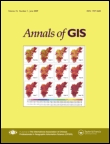
Annals of GIS
Exploring the Frontiers of Spatial ScienceWelcome to the Annals of GIS, a leading academic journal published by Taylor & Francis Ltd, dedicated to advancing the field of Geographic Information Science and its applications. With an ISSN of 1947-5683 and an E-ISSN of 1947-5691, this Open Access journal has been ensuring wide accessibility since 2019, thereby bolstering the dissemination of knowledge in areas such as remote sensing, spatial analysis, and geoinformatics. Hailing from the United Kingdom, the journal ranks impressively within its categories, achieving a Q2 status in Computer Science Applications and a prestigious Q1 ranking in Earth and Planetary Sciences for 2023, placing it in the top 10% among its peers. With a focus on innovative research spanning from 2009 to 2024, the Annals of GIS serves as a vital platform for researchers, professionals, and students alike, providing insights and fostering discussions that push the boundaries of geographic technologies and their real-world applications.